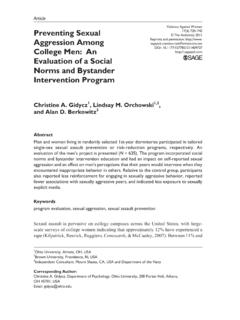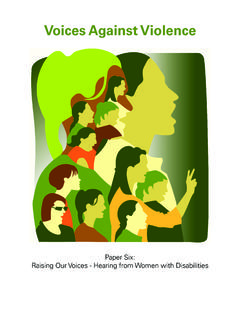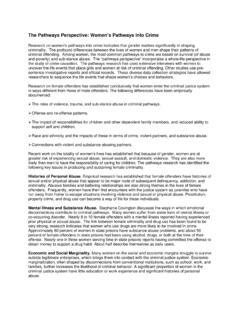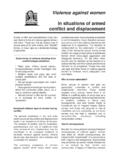Transcription of Working with Men to Prevent Violence Against …
1 Applied Research Forum National Electronic Network on Violence Against women Working with Men to Prevent Violence Against women : an overview (Part One). Alan D. Berkowitz There is a growing awareness that men, in This paper provides a brief overview of what is partnership with women , can play a significant role in known about effective strategies for involving men in ending Violence Against women . This has led to an Violence prevention efforts from the perspective of increase in programs and activities that focus on men who are recipients of anti- Violence programs as men's roles in Violence prevention. Men should take well as from the men who provide them. It defines responsibility for preventing Violence Against women the term prevention for men's Violence Against because of the untold harm it causes to women in women , reviews best practices for involving men men's lives and the ways in which it directly hurts and for tailoring programs (for men in general and men.)
2 Violence Against women hurts men when it for particular groups of men) and, in Part Two, results in women being afraid of or suspicious of offers examples of prevention program formats and men due to fear of potential victimization and when it pedagogy. These examples are provided to illustrate perpetuates negative stereotypes of men based on best practices rather than to describe specific the actions of a few. The behaviors and attitudes programs, as this review is not intended to be that cause Violence Against women may also be a exhaustive or comprehensive of all Violence preven- cause of men being violent towards other men. tion efforts involving men. Finally, in order to be These same behaviors and attitudes may also keep useful to practitioners and educators the paper men from having close and meaningful relationships provides references to websites containing informa- with each other. Finally, while only a minority of tion about men's anti- Violence organizations and men are violent, all men can have an influence on the programs.
3 While the conclusions and trends noted culture and environment that allows other men to be here are applicable to the prevention of all forms of perpetrators. For example, men can refuse to be men's Violence Against women , the preponderance bystanders to other men's violent behavior. of literature cited is from the rape prevention field For all of these reasons men have a stake in where there has been more research conducted on ending Violence Against women . To do this, men this subject. must accept and examine their own potential for Violence and take a stand Against the Violence of Defining Men's Roles in Prevention other men. In recent years, a number of authors have argued persuasively that men need to take Men can Prevent Violence Against women by not responsibility for preventing men's Violence Against personally engaging in Violence , by intervening women , both in the United States (Berkowitz, Against the Violence of other men, and by addressing 2002a; Funk, 1993; Katz, 1995; Kilmartin, 2001; the root causes of Violence .)
4 This broad definition Kivel, 1992), and internationally (Brienes, Connell, provides roles for all men in preventing Violence & Eide, 2000; Flood, 2001, 2003; INSTRAW, Against women . Men's involvement can take the 2002; Kaufman, 2001). form of primary or universal prevention (directed at all men, including those who do not appear to be at Working with Men to Prevent Violence Against women : an overview (October 2004) Page 1 of 7. VAWnet is a project of the National Resource Center on domestic Violence 800-537-2238 TTY 800-553-2508 Fax 717-545-9456. *The views expressed in this document may not reflect the official policy of VAWnet, the National Resource Center on domestic Violence , or the Pennsylvania Coalition Against domestic Violence . VAWnet Applied Research Forum risk of committing Violence and those who may be at longer-term partnerships. In actuality it is important risk for continuing a pattern of Violence ), through for all men to be involved in the prevention of all secondary or selective prevention (directed at men forms of Violence Against women , even when it may who are at-risk for committing Violence ), and/or be developmentally or strategically appropriate to through more intensive tertiary or indicated preven- foster this involvement by focusing initially on one tion (with men who have already been violent).
5 Form of men's Violence . For Violence prevention these distinctions may be somewhat artificial because it can be argued that What Works in Men's Violence Prevention? all men are at risk for perpetration by virtue of their socialization as men (Hong, 2000; Kaufman, 1985), Due to evaluation literature that is limited in because men can commit Violence without defining it scope, it is difficult to assess the effectiveness of as such, and because men who have been violent Violence prevention programs for men. For can successfully participate in programs to Prevent example, most prevention program assessments other men's Violence . Prevention is defined here measure changes in attitudes that are associated with as any program or activity that reduces or prevents a proclivity to be violent rather than actual violent future Violence Against women by men. Programs behavior. Reviews of the literature suggest that for men who already have a documented history of sexual assault prevention programs for college men Violence Against women , such as batterer's or can be effective in improving attitudes that may put perpetrator treatment programs, will not be dis- men at-risk for committing Violence Against women , cussed here.
6 Although these attitudinal changes are often limited to Prevention programs can take the form of one periods of a few months (Brecklin & Forde, 2001;. session, a series of sessions or ongoing interactive Breitenbecher, 2000; Lonsway, 1996; Schewe, educational workshops, leadership training, social 2002). In contrast, programs that focus only on marketing and social norms media campaigns providing information have not been found to be (defined in Part Two of this paper), or through effective (Schewe, 2002). Among pre-college aged participation in one-time or ongoing public events. males, dating Violence and harassment prevention These may focus directly on the issue of Violence or programs offered to mixed gender groups in school on its specific forms (for example, sexual assault, settings can result in both attitude and behavior domestic Violence , dating Violence and/or harass- change for a few months or longer (Avery-Leaf &. ment, and stalking), or indirectly through men's Cascardi, 2002).
7 Involvement in consciousness raising, fatherhood Despite the limited research, there is an and/or skill-building programs that foster attitudes emerging consensus regarding what constitutes and behaviors that may protect Against Violence , or effective Violence prevention for men. Violence by providing healthy resocialization experiences prevention programs that have been found effective about what it means to be a healthy, nonviolent man. in evaluation studies tend to share one or more of In its broadest definition, Violence prevention for the assumptions listed below. Practitioners who men includes any activity that addresses the root work with men to Prevent Violence have also causes of men's Violence including social and concluded that effective Violence prevention structural causes as well as men's gender role programs for men share some or all of these socialization and men's sexism. assumptions: Among men's Violence prevention programs Men must assume responsibility for those for school-aged boys have tended to focus on preventing men's Violence Against women .
8 Issues of sexual harassment and dating Violence , Men need to be approached as partners in those for college age men have tended to focus on solving the problem rather than as sexual assault, and those for men not in college or perpetrators. older have tended to focus on domestic Violence in Working with Men to Prevent Violence Against women : an overview (October 2004) Page 2 of 7. VAWnet is a project of the National Resource Center on domestic Violence 800-537-2238 TTY 800-553-2508 Fax 717-545-9456. VAWnet Applied Research Forum Workshops and other activities are more The majority of men may already hold attitudes effective when conducted by peers in small, that can be strengthened to Prevent and reduce all-male groups because of the immense Violence and encourage men to intervene with other influence that men have on each other and men. For example, research has demonstrated that because of the safety all-male groups can most men are uncomfortable with how they have provide.
9 Been taught to be men, including how to be in Discussions should be interactive and relationship with women , homophobia, encourage honest sharing of feelings, ideas, heterosexism, and emotional expression, and that and beliefs. they are uncomfortable with the sexism and Opportunities should be created to discuss inappropriate behavior of other men (Berkowitz, and critique prevailing understandings of 2003; 2004). Because many men already feel masculinity and men's discomfort with them, blamed and are on the defensive about the issue of as well as men's misperceptions of other men's Violence (even when this defensiveness is men's attitudes and behavior. misplaced), effective approaches create a learning Positive anti- Violence values and healthy environment that can surface the positive attitudes aspects of men's experience should be and behaviors that allow men to be part of the strengthened, including teaching men to solution. This can be accomplished in the context of intervene in other men's behavior.
10 A safe, nonjudgmental atmosphere for open Work with men must be in collaboration discussion and dialogue in which men can discuss with and accountable to women Working as feelings about relationships, sexuality, aggression, advocates, educators, and prevention etc. and share discomfort about the behavior of specialists. other men. What is the Logic of these Assumptions? First, What Types of Discussions are Effective? research and experience have shown that putting Literature reviews have suggested that the quality men on the defensive or using blame is not effective and interactive nature of the discussion may be more and can even result in negative outcomes. Thus, in important than the format in which it is presented Lonsway's review of the literature she stated: (Breitenbecher, 2000; Lonsway, 1996), a dimension although educational programs challenging rape that Davis (2000) has called program process.. culture do require confrontation of established Because men are influenced by other men and by ideologies, such interventions do not necessitate a what men think is true about other men, this style of personal confrontation (Italics added, influence can be positively channeled in all-male 1996, p.)












